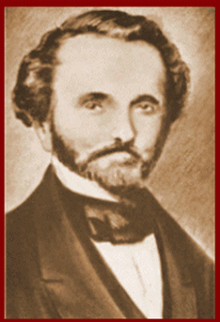William Hepburn Russell
| William Hepburn Russell | |
|---|---|
 | |
| Born |
January 31, 1812 Burlington, Vermont |
| Died |
September 10, 1872 Palmyra, Missouri |
William Hepburn Russell (1812–1872) is often credited along with Alexander Majors and William B. Waddell as the founders, owners, and operators of the Pony Express. His public life is one of numerous business ventures, some successful and some failed. While Russell, described as a good-looking man, lived the majority of his life on the edge on the western frontier, he was always more at home in the upper-class settings of the East coast.[1]
Early life
Russell was born in Burlington, Vermont on January 31, 1812.[2] In the early 1820s, he moved as a child with his family to western Missouri. In 1826, at the age of 16 and with little formal education, he began work at the Ely & Curtis general store in Liberty, Missouri. Two years later, in 1830, he began working for the mercantile firm of James Aull and Samuel Ringo, where he learned the wholesale business.[3]
Marriage and family
In 1835 he married Harriet Elliot Warder, whose social standing helped his. in 1835, a move that established his standing in society.[4]
Early business ventures
In 1837 at the age of 25, Russell left the Aull and Ringo firm to strike out on his own. He helped to organize the Lexington First Addition Company in 1840 with his future partner, William B. Waddell. In 1844, using borrowed money, Russell created the partnership of Bullard & Russell with James H. Bullard to open a general store.[2] This partnership soon welcomed an additional partner in E.C. McCarty and expanded to shipping goods to Santa Fe.[5] He then went on to become a partner in the established firm of Waddell, Ramsey & Co. While some of these early business ventures ended in failure, by 1848, Russell was successful enough to build a 20-room mansion in Lexington, Missouri.[6]
In 1850, in partnership with James Brown, and John S. Jones, Russell entered the military freighting business and sent 135 military goods.?[2] This partnership dissolved soon after the death of Brown in 1850. In 1852, he re-partnered with William B. Waddell to form a mercantile firm; by 1854 they freighted military supplies to Santa Fe.[7]
The Pony Express
Russell teamed with Waddell and Alexander Majors on December 28, 1854 to form the corporation of Russell, Majors, and Waddell.[8] Acting as the firm's representative in Washington, D.C., Philadelphia, and New York, he lobbied for contracts with the War Department as well as financing from banks and other, less reputable sources. This partnership later formed the Central Overland California and Pikes Peak Express Company on November 19, 1859, with the hope of receiving a mail contract.[9] Under charter from the Kansas legislature, the Pony Express(as the C.O.C. & P.P.E Company came to be known) began operations on April 3, 1860. This business venture would prove to be a failure, losing upwards of $1,000 a day.[10] By October 1861, the Pony Express was out of business due to the completion of the telegraph lines and the unwillingness of the national government to provide further funding.
Russell became mixed up in a scandal involving Secretary of War John Buchanan Floyd and Godard Bailey, a clerk for the Department of Interior. After requesting and being denied funding for the Levenworth & Pike’s Peak Express Company (forerunner to the C.O.C. & P.P.E.C) from Floyd in 1858, Russell requested aid from Bailey. Through a series of illegal transactions, the money was obtained from the Indian Trust Fund. However, on December 1, 1860, Bailey confessed to Floyd and was arrested and brought to trial along with Russell. Although the verdict was largely covered up by the start of the American Civil War, Russell and the Company had lost face.[11]
Later years
Deep in debt and without his previous social connections, Russell attempted to regain his fortunes in a Colorado gold mining venture that resulted in failure. His assets were sold in April 1865 to pay off creditors. He went to a brokerage partnership with Thomas P. Akers in New York, a venture that also failed. Due to failing health he returned to Missouri to live first with his daughter in St. Louis and then with his son in Palmyra where he died September 10, 1872, at age 60.[12]
See also
- Pony Express
- Central Overland California and Pikes Peak Express Company
- Russell, Majors and Waddell
- William B. Waddell (Pony Express founder)
- Postage stamps and postal history of the United States
References
- ↑ Christopher Corbett, Orphans Preferred: The Twisted Truth and Lasting Legend of the Pony Express (New York: Broadway Books, 2003), 19.
- ↑ 2.0 2.1 2.2 Raymond W. and Mary Lund Settle, War Drums and Wagon Wheels: The Story of Russell, Majors, and Waddell (Lincoln, Nebraska: University of Nebraska Press, 1966), 245.
- ↑ Raymond W. and Mary Lund Settle, Saddles and Spurs: The Pony Express Saga (Lincoln, Nebraska: University of Nebraska Press, 1955), p. 2.
- ↑ “Russell, William Hepburn”, American National Biography Online
- ↑ Settle (1955), "Saddles and Spurs", p. 3
- ↑ Russell Mansion, National Park Service
- ↑ Settle (1955), "Saddles and Spurs", p. 4
- ↑ Raymond W. and Mary Lund Settle, War Drums and Wagon Wheels: The Story of Russell, Majors, and Waddell (Lincoln, Nebraska: University of Nebraska Press, 1966), 245-246.
- ↑ Ralph Moody, Stagecoach West (New York: Thomas Y. Crowell Company, 1967), 182-183.
- ↑ Ibid., 185-186.
- ↑ Raymond W. and Mary Lund Settle, War Drums and Wagon Wheels: The Story of Russell, Majors, and Waddell (Lincoln, Nebraska: University of Nebraska Press, 1966), 131-155.
- ↑ Raymond W. and Mary Lund Settle, Saddles and Spurs: The Pony Express Saga (Lincoln, Nebraska: University of Nebraska Press, 1955), 199.
Template:Palmyra, Missouri
| ||||||||
|